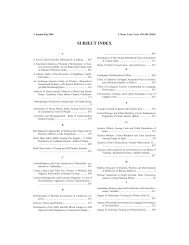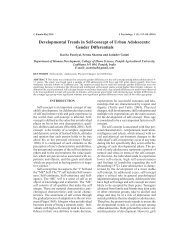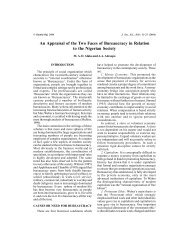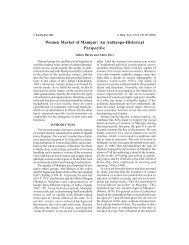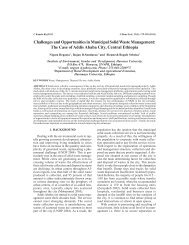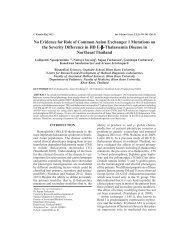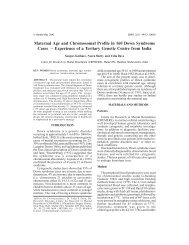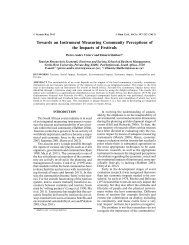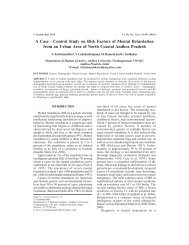Views on the Origins, Structure and Hierarchy of Some Niger Delta ...
Views on the Origins, Structure and Hierarchy of Some Niger Delta ...
Views on the Origins, Structure and Hierarchy of Some Niger Delta ...
You also want an ePaper? Increase the reach of your titles
YUMPU automatically turns print PDFs into web optimized ePapers that Google loves.
56<br />
abstracted like <strong>the</strong> figures representing Odenowa,<br />
Atabruta <strong>and</strong> Oku. Odenowa is a god from<br />
Bayelsa State depicting <strong>the</strong> god <strong>of</strong> harvest<br />
(Eniemokumo 2006). Structurally it reminds <strong>on</strong>e<br />
<strong>of</strong> an ant-hill riddled with holes (Fig. 9). These<br />
holes may not be accidental but might represent<br />
vital organs <strong>of</strong> <strong>the</strong> body.<br />
The o<strong>the</strong>r work called Atabruta is depicted as<br />
a phallic-like structure representing <strong>the</strong> god <strong>of</strong><br />
“peace”. It is designed like a male reproductive<br />
organ. While <strong>the</strong> work from Otuokpoti town in<br />
Ogbaia Local Government Area in Bayelsa State<br />
represents Oku god <strong>of</strong> adverting famine<br />
(Eniemokumo 2006). This object resembles a head<br />
springing from <strong>the</strong> grass.<br />
Benin Mud Sculptures<br />
The Urh<strong>on</strong>igbe shrine lies between two<br />
western Igbo communities <strong>of</strong> Umutu <strong>and</strong> Abavo.<br />
It is associated with <strong>the</strong> ancestral worship <strong>of</strong> <strong>the</strong><br />
Olokun deity.<br />
The Olokun figures are highly stylized with<br />
tinges <strong>of</strong> semi-naturalism stamped <strong>on</strong> a few <strong>of</strong><br />
<strong>the</strong>m. So <strong>the</strong>re is perhaps, a mixture <strong>of</strong> two styles<br />
in <strong>the</strong> Urh<strong>on</strong>igbe tableaus. Am<strong>on</strong>gst <strong>the</strong> statues<br />
depicted are various postures <strong>of</strong> security men,<br />
flutists, armour bearers, chiefs, palace guards,<br />
wives, attendants <strong>and</strong> <strong>the</strong> Olokun figure. <strong>Some</strong><br />
<strong>of</strong> <strong>the</strong> statues are modelled with pieces <strong>of</strong> mirrors<br />
Fig. 8. Agbarha-Otor Onoku tableau 2007<br />
Fig. 9. The figure <strong>of</strong> Oden<strong>on</strong>a<br />
ESE ODOKUMA<br />
inserted in <strong>the</strong>ir eye–regi<strong>on</strong>, thus, signifying <strong>the</strong><br />
positi<strong>on</strong> <strong>of</strong> Olokun in <strong>the</strong> sea. There are also<br />
multi-coloured depicti<strong>on</strong>s <strong>of</strong> figures within <strong>the</strong><br />
corpus. These features are comm<strong>on</strong> in most<br />
<strong>Niger</strong> <strong>Delta</strong> cultures <strong>and</strong> <strong>the</strong>y c<strong>on</strong>jure religious<br />
significance. Such colour values include red<br />
symbolizing <strong>the</strong> strength <strong>of</strong> <strong>the</strong> deity <strong>and</strong> white<br />
purity. <strong>Some</strong> <strong>of</strong> <strong>the</strong> Olokun figures seem to emerge




